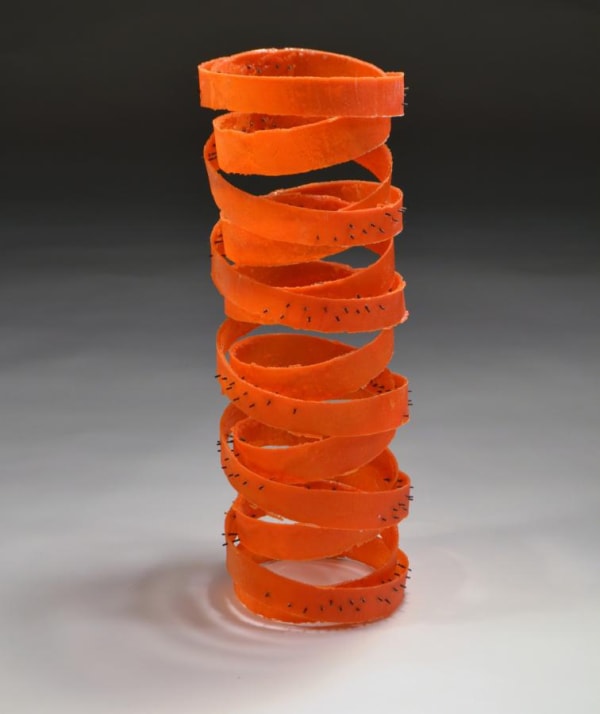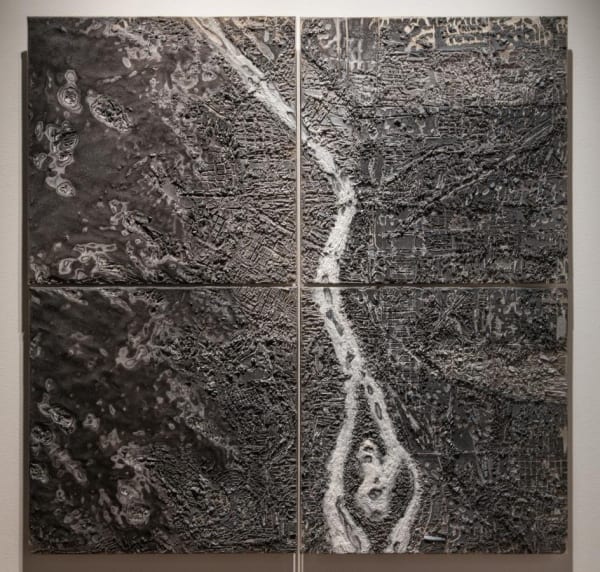A bright orange spiral sits upright in a glass case. A little over a foot tall, it appears to be made of flexible material. But Rei Chikaoka’s piece “Updraft” is actually kilncast glass and metal.
When you think of glass artwork, Chihuly might be the first artist to come to mind. His blown glass creations are known worldwide and rightfully so. Bellevue Arts Museum (BAM) is showcasing the broader dimensions of what glass can transform into. They’re hosting the traveling show, “Emerge/Evolve 2016: Rising Talents in Kiln-Glass.”
The show will have visitors doing a double take because much of it doesn’t look like glass.
Ligia Bouton’s “Green Wallpaper #1” appears to be printed tapestry hanging on a wall. Kate Clements’ “Garden” looks like flowers and leaves made of lace. Rei Chikaoka’s “Curve” looks like a powder blue coil made of plastic.
It’s difficult to keep one’s tactile urges in check and follow standard museum rules of not touching the artwork. Guest Curator Michael Endo said people are blown away by the work in the show.
“They see this, they can’t believe it’s glass. They didn’t know the glass could take these forms,” Endo said. “They didn’t know how plastic and malleable it is as a material — how mutable it is.”
The artists in the show are winners of the Portland-based Bullseye Glass Company’s Emerge 2016 competition. A jury chose seven winners and three finalists out of more than 370 entries from around the world. The Evolve section shows the progression of past finalists. This is the second time the Emerge/Evolve exhibition is being shown at BAM.
Bouton used powder printing for her three “Wallpaper” pieces in the show. Endo said it’s a screenprinting technique that uses glass powder rather than ink to create the pattern. The three green and blue works have folds and the appearance of an object pushing through.
“A lot of Ligia’s work has that reference to anthropomorphism, so a lot of items or spaces coming to life or having a history of life to them, and this particular body of work, had to do with breath,” Endo said. “After she laid down the glass powder she uses a straw to blow into it and then revealed the layers of glass in between.”
The gem of the exhibition is arguably Jeffrey Stenbom’s “Every Year.” The installation is of 7,300 individually powder-printed dog tags on white glass. They represent a year’s worth of veteran suicides. Each tag is the physical embodiment of a service member who is no longer suffering.
Stenbom is a Minnesota-based artist. He joined the United States Army after 9/11 and was deployed to Iraq. After serving he dealt with post-traumatic stress disorder. His interest in sculpture stems from his experience as a soldier. In his artist statement, Stenbom said he has a new appreciation for life.
“Being wounded and dealing with the pains of combat (both mentally and physically) takes a toll on a person. These experiences have led me to search for passionate and creative means of exploring my emotions, political beliefs, personal views of the world around me and psychological distress,” Stenbom wrote. “I feel art is not meant to fix problems, but to make others aware that they exist. This awareness may lead to change or at the very least comfort and understanding through conversation.”
The dog tags are mounted on a wall in a grid, behind Stenbom’s “To Those Who Have,” a large set of translucent dog tags hanging from the ceiling. Illuminated by a single white light, it has a memorial effect.
Carmen Vetter’s “Portland” is four individual frames creating a larger square map of the Rose City. It has the appearance of an aerial view of a landscape. For those familiar with the city’s layout, landmarks including the Willamette River, Forest Park and the West Hills neighborhood are visible.
“I’m so into texture and layering. Exposing and removing and the passage of time, and age and how that relates to life,” Vetter said. “I kind of feel like I get to talk about how I feel with this material because I can lay it down and layers and then destroy it and remove it and pull it off, and put it through the fire and bring it back out. The whole process just relates.”
Vetter isn’t formally trained and is almost completely self-taught. She considers herself a maker and was destined to become an artist. She used to create abstract paintings in the style of Georgia O’Keefe but took a break when she became a mother. Vetter dove back into the art world when a friend introduced her to mosaics. That led to her taking a kiln glass class at Bullseye, and she’s been captivated ever since.
Some of her work is influenced by spending hours upon hours looking at Google Earth images. Growing up she spent a lot of time with her grandmother who is a quilter, which has influenced her work, allowing her to look at connectivity.
“It’s always evolving for me. Everything is always changing,” Vetter said. “I don’t tend to stay with anything very long. The thing that stays consistent in my work is the square. Everything is a grid, the work is always modular. I always work in a 21-inch square. I like the parameters of that. For me that helps with creativity for me to limit myself to something.”
Vetter said the creative process is what’s important to her. She eagerly heads down to her basement to work on a project.
“Sometimes I still pinch myself now because I get to do this,” Vetter said. “I just didn’t ever really think that this is the way I would get to spend my life. This is such a privilege what I get to do. I’m so lucky.”
Cheryl Wilson-Smith’s “Promises and Lies: Keeping Score” shows 49 nailed -down white squares. Each individual square is made up of multiple layers of glass that resemble tissue paper. Endo said Wilson-Smith used an analog 3-D printing process.
Artists attracted to the medium of kiln-glass vary from the novice to the professional. Endo said the learning curve for kiln-glass isn’t steep. Unlike blown glass where a furnace is required, only a kiln is needed.
The glass manufactured by Bullseye is a soda lime glass, and it’s specifically formulated for fusing. For those curious about the process artists use, an interactive area is set up. It allows visitors to touch glass samples after they have been sandblasted, engraved and polished, as well as what the glass looks like at different temperatures. There’s also a kilnforming and coldworking samples section.
“Emerge/Evolve” is technically and conceptually splendid. The artists are pushing the boundaries and misconceptions of glass artwork in beautiful ways.
WHAT: "Emerge/Evolve 2016: Rising Talents in Kiln-Glass"
WHEN: May 26 - October 1.
WHERE: Bellevue Arts Museum, 510 Bellevue Way NE, Bellevue
Lisa Edge is a Staff Reporter covering arts, culture and equity. Have a story idea? She can be reached at lisae (at) realchangenews (dot) org. Twitter @NewsfromtheEdge
Source Link: Real Change News









